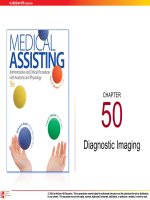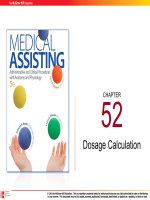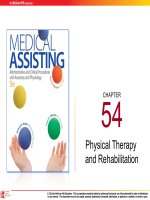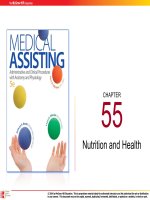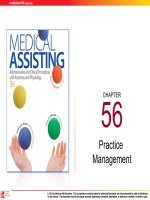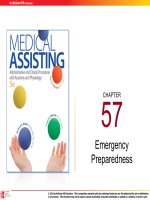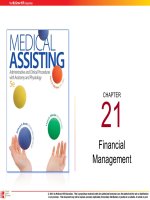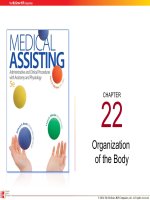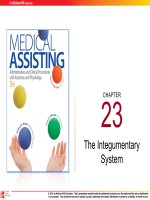Medical assisting Administrative and clinical procedures (5e) Chapter 14 Patient education
Bạn đang xem bản rút gọn của tài liệu. Xem và tải ngay bản đầy đủ của tài liệu tại đây (1.04 MB, 46 trang )
CHAPTER
14
Patient Education
14-2
Learning Outcomes (cont.)
14.1 Identify the benefits of patient education and
the medical assistant’s role in providing
education.
14.2 Describe factors that affect learning and
teaching.
14.3 Implement teaching techniques.
14.4 Choose reliable patient education materials
used in the medical office.
14-3
Learning Outcomes (cont.)
14.5 Explain how patient education can be used
to promote good health habits.
14.6 Describe the types of information that should
be included in the patient information packet.
14.7 Describe the benefits and special
considerations of patient education prior to
surgery.
14-4
Introduction
• Health education = lifelong pursuit
• Encourage and teach healthy habits and
behaviors
• Medical assistants
– Recognize and overcome roadblocks to education
– Become comfortable with teaching
– Lead others to their highest level of health
14-5
The Educated Patient
Is better informed about how to
maintain a healthy state
Is often more compliant with treatment
programs
Takes a more active role in medical care
14-6
The Educated Patient (cont.)
• Benefits to the medical office
– Satisfaction
– Follows instructions
– Less likely to call with questions, so staff spends less
time on the telephone
• Medical assistant participation in patient
education
– Place of employment and scope of practice
– Awareness of patient understanding and needs
14-7
Apply Your Knowledge
What are the results of patient education?
ANSWER: Patients can take a more active role in
their health care. They are more compliant with the
treatment program, stay healthier, and are more
satisfied clients of the medical practice.
14-8
Learning and Teaching
• Learning
• Domains of learning
Knowledge
Cognitive
Behaviors
Affective
Skills
Psychomotor
14-9
Apply Your Knowledge
ANSWER:
Match the following:
P Sylvia is taking her medications
Cognitive
correctly
C Sylvia understands the effect of her
Affective
diabetic diet.
Psychomotor
P Sylvia started exercising to help her
keep her diabetes under control.
A Sylvia has a positive attitude about
her ability to control her diabetes.
C Sylvia is able to recall information
about diabetes.
A Sylvia is motivated to learn.
14-10
Teaching Techniques
• Types of teaching
Factual – Knowledge
(cognitive domain)
Sensory – Behaviors
(affective domain)
Participatory – Skills
(psychomotor domain)
14-11
Teaching Techniques (cont.)
• Factual Teaching
– Provides details
– Supported by written
materials
• Sensory Teaching
– Physical sensations they may feel
– All five senses may be involved
14-12
Teaching Techniques (cont.)
• Participatory teaching
– Describe a technique
– Modeling
• Demonstrate the
technique
• Patient then performs a
return demonstration
• Verify understanding
14-13
Cultural and Educational Barriers
• When providing new materials consider
–
–
–
–
–
–
–
Cultural background
Age
Medical condition and emotional state
Learning style, educational background
Disabilities
Religious background
Readiness to learn
14-14
Apply Your Knowledge
True or False?
ANSWER:
F Return demonstrations are part of factual teaching.
participatory teaching.
T Sensory teaching tells the patient what he will feel
during a procedure.
T Factual teaching provides the patient the what, when,
and why.
T Modeling is teaching a new skill through observation
and imitation.
14-15
Patient Education Materials
• Brochures, Booklets, and Fact Sheets
– Explain procedures
– Provide information about specific diseases and
medical conditions
– Provide information to help patients stay healthy
14-16
Printed Materials (cont.)
Educational Newsletters
• Practical health care tips
• Updates on office policies
• Information about new diagnostic
tests and equipment
• News about office staff
14-17
Printed Materials (cont.)
Community-Assistance
Directory
A valuable aid for referring patients to
appropriate agencies
Meals
on
Wheels
Medical
Services
Day
Care
Centers
14-18
Visual Materials
DVDs and videotapes – effective for
educating about complex subjects and
procedures
Many physicians arrange seminars
and classes for their patients.
14-19
Visual Materials (cont.)
Libraries and patient
resource rooms have a
variety of educational
materials.
Health organizations and
associations also provide
health information.
14-20
Visual Materials (cont.)
• Online health
information
– Check credibility of
website
– Develop a list for the
patient
• Education plan
–
–
–
–
–
Education needs
Outline
Resources
Teach
Evaluate
14-21
Apply Your Knowledge
List resources that are available to provide patient
education materials.
ANSWER: Community resources for patient education
include libraries and patient resource rooms, online
resources, community resources such as home health, and
health-related associations such as the AHA.
14-22
Promoting Health and Wellness Through
Education
• Consumer Education – increased awareness
of good health practices
• Ways to achieve good health
– Develop healthy habits
– Protect self from injury
– Take preventive measures
14-23
Healthy Habits
Adequate Rest
Good Nutrition
Regular Exercise
14-24
Healthy Habits (cont.)
Limit Alcohol
Intake
No Smoking
Work
Leisure
Balance
14-25
Protection from Injury
• Safety measures
• Proper use of medications
– Do not change dosage
– Do not mix medications
– Report unusual reactions
– Tell doctor about any OTC medications
